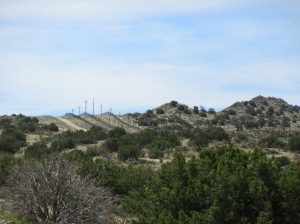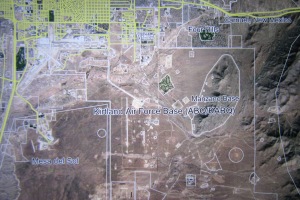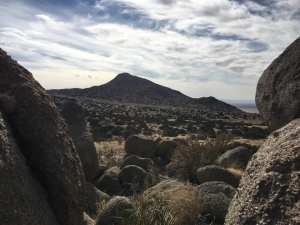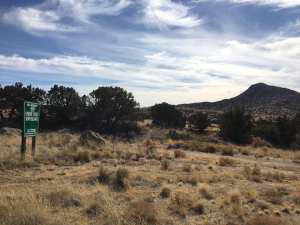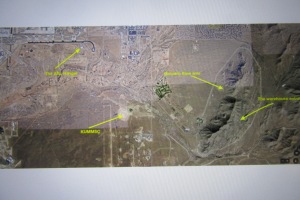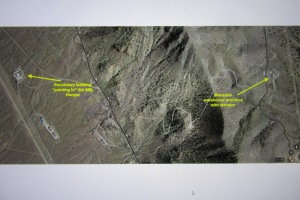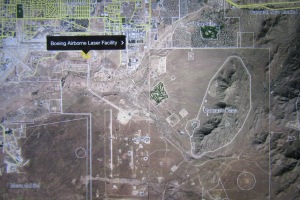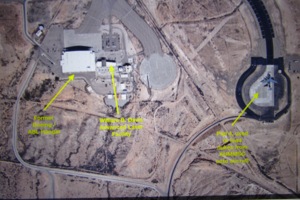(CLICK ABOVE FOR ENLARGEMENT – – Northeast end of the Manzano underground base with 3 tiers of electric fences, almost right next to the Four Hills community of Albuquerque – – the base was supposedly totally closed down in 1992 – – photo by Norio Hayakawa)
FROM AN ANONYMOUS SOURCE – – (Temporarily I would have to call him Mr. “X”, but he says people can call him “Bill” or “Joe”) – – November 15, 2021
(QUOTE)
“I’m a lifelong Albuquerque resident. I appreciate the work you’ve put into researching and uncovering the various mysterious topics you discuss.
About three years ago, a close relative of mine, a young man, was working a job as a construction laborer with a local firm, which in 2018 was contracted to do work on KAFB. He worked that job for about three weeks. At the time, I didn’t pay much attention to what he told me after coming home from work each evening, but a few years later I took much more interest, due to the nature of his descriptions of what he encountered.
The following is an essay I wrote, based on his direct eyewitness testimony, which also includes my attempts to explain, in the form of hypothesizing, the larger purpose of the facility that he visited. I call this The Able Prime Narrative; at the time it was built, Manzano Base was known as Site Able.
(CLICK ABOVE FOR ENLARGEMENT)
I’ve tightly held onto this information for some time, but am sharing it with you because it’s one of the most astonishing factual tales I’ve yet encountered, and I trust your judgement in regard to what you might do with this information. As you undoubtedly know, there are many unverifiable, or unreliable, stories that have circulated through the UFO subculture community. This story is one of the most factual I’ve encountered, due to the veracity of this young man’s testimony.
The facts as described by this young man, who I call The Eyewitness, are in my view entirely trustworthy; he’s too young and naive to have a deep enough understanding of these things to have made them up, nor has he shown any interest in the past with these topics. My attempts at explaining what this story implies remains my own speculation, and hence is subject to my own errors of judgement; but his account is by my estimation entirely trustworthy. I’ve also brought a close friend of mine into confidence of this story, who has, together with me, interviewed The Eyewitness and has verified the veracity of his story and lack of any obvious contradictions or counter-factual information that might compromise the story’s integrity.
INTRODUCTION
Able Prime is based on facts, of an actual eyewitness account from a very reputable source, of an apparent underground complex located within the boundaries of Kirtland Air Force Base (KAFB) in Albuquerque, New Mexico.
(CLICK ABOVE FOR ENLARGEMENT – – photo by Norio Hayakawa, Nov. 17, 2021)
The veracity of Able Prime is based on the testimony of a firsthand source who has been in this underground facility multiple times over the course of three weeks; said source possesses a high degree of believability, due to his naiveté of military and aviation-related subject matter; his consistency in recounting these events over multiple interview sessions; and personal knowledge of this individual over the entirety of his life. Said individual has not demonstrated in the past any interest in outlandish subject matter such as conspiracy theories or UFOs. He has also remained tight-lipped about what he witnessed, only revealing to me the details after much conversation. There does not appear to be any personal motive of financial gain or fame exhibited by this source. The identity of this source will be kept in confidence and only referred to as The Eyewitness.
(CLICK ABOVE FOR ENLARGEMENT – – this public open space area right next to the fenceline of the base is off-limits to the public after sundown, according to the city ordinance – – this sign says: BE ADVISED, AREA MAY BE UNDER VIDEO SURVEILLANCE – – photo by Norio Hayakawa, Nov. 17, 2021)
BACKGROUND
During the Manhattan Project of WWII, Kirtland Field in Albuquerque was operated by the US Army Air Corp and employed as a point of demarcation for materiel and personnel involved with the build-up of atomic munitions on Tinian Island, in preparation for the atomic bombing raids over Hiroshima and Nagasaki, Japan, which directly contributed to the ending of hostilities and unconditional surrender of Japan.
After the war, Z Division of Los Alamos was moved to Kirtland Field and became Sandia Base, a separate entity commanded by a series of US Army and Air Force generals. The facility rapidly expanded to become the nexus of what is known today as Sandia National Laboratory, the primary center of nuclear weapons development during the Cold War. In 1971, Kirtland Field and Sandia Base were merged into Kirtland AFB.
In the late 1940s a facility began to be constructed inside the mountains on the eastern boundary of Sandia Base that became known as Manzano Base, or Site Able, one of six such sites located around the US built to stockpile the nation’s nuclear weapons arsenal. Site Able was special in that, not only was it the first such site, but it was the primary assembly facility used to construct the early plutonium fission weapons, based on the WWII Fat Man design, known as the Mark 4. During this time, plutonium and uranium weapons components were cast and machined at Los Alamos, delivered to Sandia Base and assembled, along with non-nuclear components from other facilities, in an underground assembly factory in Manzano Base.
The Mark 4 design was assembled by hand, in kit form, from discrete blocks of high explosive lenses, upon which detonators and other components were added, to form the completed weapon, minus the core itself, which was only inserted into the weapon during final delivery by bomber aircraft to its target. Assembled weapons were stored in the Manzano facility, minus their cores, which were stored in separate, lead-lined “bird cage” containers.
(CLICK ABOVE FOR ENLARGEMENT – – The overall layout of Manzano and Kirtland AFB proper, including the warehouse entrance on the east side of Manzano, the former Boeing Airborne Laser Hangar, and KUMMSC)
MANZANO BASE LORE
During the height of the Cold War, the existence of Manzano Base was a poorly kept secret among the children of base workers. It was commonly discussed, on the school grounds in northeast Albuquerque, that a “secret” underground base existed in the Four Hills area of southeast Albuquerque, since many of these children had parents who worked either directly in Manzano Base proper, or on Sandia Base.
In 1992, the Kirtland Underground Munitions and Maintenance Storage Complex (KUMMSC) was activated on KAFB, south and west of the old Manzano Base, and has since become the largest repository of nuclear weapons in the US arsenal. Since then, a story was published in the local Albuquerque Journal newspaper about Manzano Base, its former purpose, and how it had since become (supposedly) idled, used only for storage of non-nuclear materiel.
The author has become aware of a book (“Raven Rock: The Story of the U.S. Government’s Secret Plan to Save Itself – – While the Rest of Us Die“, by Garrett M. Graff) written about the history of the NORAD (North American Air Defense Command) facility, located in Cheyenne Mountain, south of Colorado Springs, Colorado, which indicated that during its design phase a nearly identical mock-up facility was built within the Manzano Base complex, southeast of Albuquerque.
The author is also aware of a firsthand account, from a family friend, an independent contractor skilled in computer networks, who claimed to have been working at an underground computer complex “inside the mountain” directly after the events of September 11, 2001, in a supporting role maintaining computer network equipment.
(CLICK ABOVE FOR ENLARGEMENT – – A closer view of Manzano, with the warehouse entrance on the right and the presumed secondary entrance on the left. The alignment of the walls of the warehouse point directly to the secondary building. They are about a mile apart.)
SO, HERE IS THE STORY – – FACT OR FICTION?, YOU DECIDE:
THE ABLE PRIME NARRATIVE
The Eyewitness was working for a local construction contractor in the 2018 time frame when a job was issued on KAFB. He and his crew entered the base from the Louisiana Gate, drove east to Wyoming Blvd, then south and east, past the base golf course, to the security entrance of the Manzano Base complex. They were directed to drive on a road around the southern edge of the complex, to the eastern side, where they arrived at a warehouse building with a light-blue roof. The crew parked in the main parking lot, where they were met by security personnel, who told them to leave all cell phones, electronics and cameras in their truck, and fill out a form describing in detail all of the tools and material they would be bringing into the facility.
Immediately across the loop road from this warehouse building is the entrance to Factory 3, one of three such nuclear assembly factories once located in Manzano.
Having complied with the requests, they were escorted into the building through a door on the west-facing side, where they entered an elevator, that was described by The Eyewitness as of a “wire cage” type freight elevator, whose entrance faced west, toward the mountain, and began their descent that lasted for “three to five minutes.”
Once their three- to five- minute descent was completed, they exited the elevator in a deep underground, concrete-lined facility that extended into the distance toward the west, under the mountain.
The Eyewitness described the feeling of being in the facility as if one were deep underground inside Carlsbad Caverns, and that it felt cold.
Before them was a long, tall, concrete hallway-like structure that extended into the distance. The walls were made from large sections of rectangular concrete, embedded with a grid of holes. The ceiling was as high “as if standing on the basketball court of the UNM Pit arena and looking up to the ceiling.” The floor of the structure curved gently upward, in an arc, such that the other end of the facility could not be seen. To the left of the main hallway were a series of rooms that had been built of metal stud framing, that needed interior finishing work completed. The freight elevator was used to deliver construction materials, tools and supplies from ground level, down into the facility.
The ceiling of the long hallway was described as “corrugated concrete,” similar to the kind of reinforced concrete structures seen under freeway overpass bridges. Between the ridges of reinforced concrete were brackets extending downward, from which lighting fixtures were attached. The Eyewitness estimated the height of the hallway as around 50 feet, and the width about 200 feet.
Parked in two neat rows along either side of the hallway were dozens of aircraft, oriented diagonally facing away from the entrance. The row of aircraft on the left side had wide, flat jet engine exhaust ducts and a pair of canted vertical stabilizers. They were dark gray, with no markings other than, under the rear horizontal stabilizers, a sequence of 7 or 8 digits, preceded by the “#” (hashtag or pound) symbol. There was estimated to be 25-30 of these aircraft visible.
Because of his unfamiliarity with military aircraft, the author showed The Eyewitness a series of aircraft images, from which he identified the YF-23 prototype as being the closest to what he observed.
The row of aircraft on the right side of the structure were parked similarly to those on the left, diagonally facing away from the entrance, and were described as being black and triangular. There appeared to be an equal number of them as the “YF-23“ type, extending into the distance.
In attempting to identify this second type of aircraft, the author showed The Eyewitness images of the F-117 stealth fighter, but he indicated that the type of aircraft he observed were not shaped with flat facets as with the F-117, but instead were smooth and curved, with a central hump that reminded him of images of the B2 stealth bomber, but smaller and with a triangular plan-form.
In each of his visits to this facility that occurred over a period of three weeks, The Eyewitness and his crew worked on the interior finishing of the office-like rooms to the left of the long hallway. On the last visit, when they were preparing to exit via the elevator, the security personnel informed them of a “security breach,” and directed them to wait by the elevator while other security teams went topside. After a period of about 30 minutes they were then permitted to depart via the elevator up to ground level, from where they exited the facility and the base.
Another detail described by The Eyewitness was during the elevator rides, they would periodically pass light fixtures in the concrete elevator shaft, visible through the extruded metal sides of the elevator car, implying a series of other floors or levels in the facility. However, The Eyewitness did not at the time count the number of floors, but his feeling is that it was dozens of floors, at least.
DECIPHERING ABLE PRIME
Whatever facilities are currently situated under the Four Hills of Manzano Base, it is assumed the majority were built in the late-1940s and into the ‘50s, prior to the era of aerial surveillance by high-flying aircraft, or satellite surveillance, hence they may yet possess a higher degree of security than newer-built facilities. Of specific interest to the author is how such a facility operates, given the implication of deep underground aircraft storage requiring access to both hangars and runways.
Fortunately for the researcher, we live in an era of readily accessible satellite imagery. The author has examined in detail satellite imagery of KAFB, via Google Earth, and has found circumstantial evidence of specific structural alignments, visible from the surface, that imply possible answers to how the Manzano facility functions.
ELEVATOR ALIGNMENT
The Eyewitness described the freight elevator, that connects the surface warehouse building to the underground facility, as being orthagonal with the building’s walls. Underground, the elevator is also orthagonal with the eastern end of the long hallway-like structure. In addition, The Eyewitness describes the long hallway as extending straight into the distance, away from the elevator toward the northwest, under the mountain.
Using Google Earth, by extending a datum line from the blue-roofed warehouse building in a northwesterly direction, parallel to its east/west axis, the datum line extends about a mile under the mountain to a position adjacent to the western fence-line of the Manzano area, directly under another warehouse-like building.
It is conjectured by the author that this second building serves as a secondary access point, via elevator, to the western end of the facility, perhaps used as an emergency exit, and perhaps also feeding electrical power to the underground facility, as there appears to be a transformer substation located just adjacent to the north side of this building.
The secondary building, a mile west of the primary, does not share its alignment with the datum line, however. By properly orienting the walls of the secondary building in Google Earth, another datum line can be extended, parallel to that building’s east/west axis, another three miles to the west, where it intersects almost exactly with an aircraft hangar providing direct access to the runway system of KAFB.
This hangar is itself oriented to the main east/west runway of KAFB, and is the only aircraft hangar on this end of the base, and the closest hangar to the Manzano area complex. This hangar is the (former) Boeing Airborne Laser facility.
(CLICK ABOVE FOR ENLARGEMENT – – Area marked with yellow (not the arrow) – – Boeing Airborne Laser Facility and Hangar area)
The author conjectures that a three mile-long underground taxiway corridor connects the Manzano facility at the east, to the aircraft hangar three miles west, via an aircraft elevator located under the hangar.
(CLICK ABOVE FOR ENLARGEMENT – – Details of the Boeing ABL hangar, and the William B. Davis Advanced Laser facility adjacent to it. There’s also Pad 4, to the east, where aircraft are loaded with nuclear weapons from KUMMSC, via the curved road below. The alignment of the walls of the secondary building in the middle photo point directly to the Boeing ABL hangar.)
Comparing elevation data (available from online topographic maps) between the blue-roofed warehouse building at Manzano (5741 feet above MSL) and the Boeing Airborne Laser hangar (5298 feet above MSL), there is an elevation change of 443 feet. Assuming the aircraft elevator under the Boeing ABL hangar is, say, 50 feet deep, this implies that the facility below Manzano could be 443 + 50 = 493 feet under the mountain, about consistent with a “3 to 5 minute” ride in a slow-moving freight elevator.
Further examination of KAFB satellite imagery reveals the KUMMSC facility, located south of the datum line connecting Manzano and the hangar, to be aligned almost exactly orthogonal to the same datum line, implying a possible other underground connecting corridor to KUMMSC.
PURPOSE
The existence of a deep underground aircraft facility, verified by a reliable eyewitness, with no obvious access to runway facilities except via an implied underground corridor and elevator, begs multiple questions.
The depth of the facility, deep under a mountainous installation formerly used to protect nuclear weapons from attack, along with the stealth nature of the aircraft types observed, suggests several possibilities.
Given that these aircraft are not publicly known to exist, their location deep under the protection of a mountain may be to warehouse them for some eventual use, perhaps as some clandestine fourth branch of the nuclear triad; a nuclear pitchfork. Given their location adjacent to, and aligned with, the KUMMSC nuclear weapons repository, perhaps they would be deployed on some long-distance bombing attack, in the event of assumption of hostilities during a nuclear exchange.
Another possibility is that they are being preserved to provide aerial dominance during a post-nuclear war phase, when the conventional air forces might have been decimated during the conflict.
It is also possible they have already been employed in various conventional conflicts. Consider KAFB itself. Sharing a common runway with the civilian Albuquerque International Sunport, civilian air traffic all but disappears late into the evening; meanwhile, air traffic over the rest of New Mexico remains scant during the early morning hours after midnight. This leaves KAFB open for clandestine flights departing and arriving under the cover of darkness, and a cooperative FAA. Aircraft can depart, fly long distances via aerial refueling, to arrive at their target coordinates halfway across the globe under the cover of nightfall; then return to KAFB under the cover of the next evening, to be sequestered away, deep under the mountain.
Advanced aircraft require constant maintenance in order to be flightworthy. Hydraulic and engine systems need to be maintained on a regular basis. Pilots require constant practice, in simulators and actual aircraft, in order for the weapons system to have any utility in warfare. It is assumed by the author that periodic clandestine flights must be ongoing from the former Boeing ABL hangar on KAFB, and also that other aircraft facilities (Edwards AFB, Nellis AFB, etc.) may be used in training and support of these activities.
THE HANGAR
The suspect hangar that may contain the terminus of an underground aircraft elevator contains no external visual identification, other than an illegible round sign or plaque above its west-facing employee entrance. There are, however, a number of vehicles parked in the adjacent parking lot, so some current activity is implied. Adjacent to the hangar is a smaller, more modern appearing building bearing a sign indicating the Richard W. Davis Advanced Laser Facility. An Internet search yields negative results for the building itself, but its namesake is an important figure in the early history of the Airborne Laser (ABL) project. In the rear of this building are a number of large compressed gas cylinders and liquid chemical containers, indicating the facility seems to support some degree of advanced laser work; but the size of the building seems too small to support such activity. It is the author’s conjecture that this laser facility may be largely underground.
It is assumed that this aircraft hangar may have supported the early years of the Airborne Laser project, including housing the early test aircraft, but that this project’s later phases may now be based elsewhere, thus leaving the hangar available for other purposes. In addition, more recent research has involved solid-state lasers, rather than the chemical COIL (carbon dioxide iodine laser) using in the ABL program.
THE ORGANIZATION
Given the secretive nature of the Manzano facility, and the history of other projects such as the U2 and A12 aircraft programs, the possibility exists that such facilities are not operated by the overt US Air Force itself, but other, more secretive, agencies. Evidence for this comes from The Eyewitness observing that there were no conventional USAF markings on the aircraft he observed in Manzano. It could be operated by some historically consistent agency such as CIA, or more obscure ones.
It is also possible that some hybrid government/private entity may have taken long term control of the facility, representing a privatization of such “Black” projects.
The facility may have been initially constructed decades ago for other purposes. Evidence of this is suggested by extending a datum line from the blue-roofed building on the east side of the Manzano complex, past the second structure on the west, continuing several miles to the northwest, that intersects directly with the central complex of Sandia National Laboratory. Given that it was common in the 1950s to build underground bomb shelters, both privately under single family dwellings and publicly, such as under the UNM campus in Albuquerque, it is likely that an underground access-way may have been built to offer secure egress, from the Sandia area to the shelter of the Manzano complex, in the event of nuclear attack by bomber (in the pre-ICBM era). This initial connective system may have been extended westward at some later date, to the hangar building, perhaps during the time when KUMMSC was being constructed, which would have offered a convenient cover story to explain the large quantities of earth being excavated during the tunnel’s construction, which would have been visible from satellite surveillance.
It is also logical to suggest that such a deeply protected aircraft facility would have had no purpose before the era of advanced stealth aircraft, since their most vulnerable moments are when parked on the tarmac; locating them underground seems to provide a logical solution in keeping with their stealth nature.
Another question I’ve asked myself is: why Albuquerque? Why not, say, Area 51, the National Security Site north of Las Vegas, Nevada? For one, we don’t know there are not also underground aircraft facilities at Area 51, especially considering Papoose Mountain is located just to the west. But as indicated previously, Manzano was already build years before the era of satellite surveillance, whereas a newer facility in Nevada would have been observed by satellite while being excavated. So Manzano provides a “legacy” facility ideal for this purpose.
Additionally, so-called “Janet” flights, of 737 charter aircraft, have to ferry personnel each work day to and from the Nevada National Security Site and the Las Vegas airport; these flights are constantly monitored by enthusiast internet watchers and also, it is assumed, foreign governments. However, with the Manzano facility no such flights of workers are necessary, since the base is adjacent to the middle-sized city of ABQ and workers can merely drive in and out of KAFB proper.
CONCLUSION
It is not the intent of the author to reveal the existence of secretive facilities merely for the purposes of notoriety or attention-getting. The facility, at least what has been directly observed by The Eyewitness, does exist. At this very moment, advanced aircraft, of a type not supposed to exist, do in fact exist, deep under the Four Hills/Manzano Base area of KAFB, four miles from the nearest runway. Billions of dollars had to have been expended in its construction, and in the aircraft procurement programs involved, without being leaked to the public through congressional oversight. Billions of dollars had to have been diverted from other programs to fund these so-called black programs. Entire systems must exist in permanence to support such back-channel funding. Covert organizations must exist, embedded in other, overt ones, to staff and support such activities. These implications beg further questions, rather than providing any answers.
Yet, secrecy doesn’t always remain secret. Facilities must be supported, often by local civilian contractors, who are exposed to things they would not ordinarily see. Word leaks out, things seen in silence are eventually spoken of, often only in whispers. Such has been the history of the civilian workforce in New Mexico since the early days of the Manhattan Project.
The author is indebted to the work of Trevor Paglen, who inspired the principle that the covert, black world often leaves a shadow, a footprint, in the everyday world we inhabit, offering mere glimpses of something beyond. It is in that spirit that I offer this work.”
(UNQUOTE)
NAME WITHHELD
Norio Hayakawa’s CIVILIAN INTELLIGENCE NEWS SERVICE
Facebook = http://www.facebook.com/fernandon.hayakawa
E-mail = noriohayakawa@gmail.com
Please also watch Norio Hayakawa’s YouTube videos
